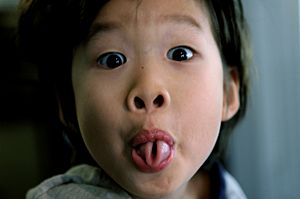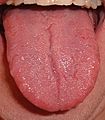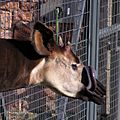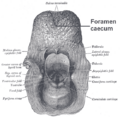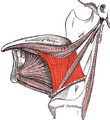Tongue facts for kids
Quick facts for kids Tongue |
|
|---|---|
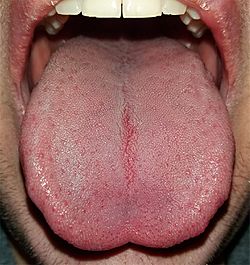 |
|
| The human tongue | |
| Latin | lingua |
| System | Alimentary tract, gustatory system |
| Artery | lingual, tonsillar branch, ascending pharyngeal |
| Vein | lingual |
| Nerve | Sensory Anterior two-thirds: Lingual (sensation) and chorda tympani (taste) Posterior one-third: Glossopharyngeal (IX) Motor Hypoglossal (XII), except palatoglossus muscle supplied by the pharyngeal plexus via vagus (X) |
| Lymph | Deep cervical, submandibular, submental |
| Precursor | pharyngeal arches, lateral lingual swelling, tuberculum impar |
The tongue is a strong, fleshy muscle inside your mouth. It helps you do many important things every day! For example, it lets you taste your favorite foods because its top surface is covered with tiny taste buds.
The tongue is also very flexible. This helps you mix food with saliva (spit) when you chew, making it easier to swallow. It's also super important for helping you talk and make different sounds. In fact, a main job of the tongue is to help humans speak and animals make vocalizations.
Your tongue has two main parts: a front part that stays in your mouth and a back part that goes towards your pharynx (the back of your throat). The left and right sides of your tongue are separated by a special kind of fibrous tissue. This tissue creates a small groove down the middle of your tongue.
There are two groups of muscles in your tongue. The first group, called intrinsic muscles, changes the shape of your tongue. These muscles are not attached to any bones. The second group, called extrinsic muscles, moves your tongue around. These muscles are connected to bones. Did you know that the tongue is often called the strongest muscle in the human body?
Contents
How Your Tongue Works
Your tongue is a busy body part! It helps you enjoy food, chew it properly, and even speak clearly. Let's explore some of its amazing jobs.
Tasting Food
When you eat, chemicals from your food, called tastants, dissolve in your saliva. These tastants then touch special cells in your taste buds. These cells are called taste receptor cells. This is how your brain knows what you are tasting!
Your tongue has many taste buds on its top surface. Each taste bud has tiny taste receptor cells. These cells can sense different types of tastes. For example, some cells detect sweet things, while others sense bitter, salty, or sour flavors. There are also cells that detect a savory taste called umami. Scientists are still learning a lot about umami receptor cells.
Chewing and Swallowing
The tongue is a very important helper in your digestive system. It helps you chew your food and get it ready to swallow. As you chew, your tongue pushes the food against the hard roof of your mouth, called the hard palate. This helps to crush and soften the food.
The top surface of your tongue has a tough, protective layer. This layer helps your tongue grind food against your hard palate without getting hurt.
Speaking Clearly
The muscles inside your tongue, the intrinsic muscles, are very important for speech. They allow your tongue to change its shape in many ways. This shaping of the tongue helps you make all the different sounds needed for talking.
Tongues in Other Animals
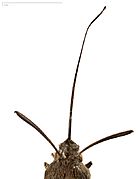
Most vertebrate animals, like amphibians, reptiles, birds, and mammals, have tongues. The muscles in their tongues developed from parts of their skull. Many amphibians grow a proper tongue after they change from a tadpole into an adult.
In mammals like dogs and cats, the tongue is often used for cleaning. They lick their fur and body to remove oils and tiny bugs. Their tongues have a rough texture, which helps them clean effectively. Some dogs might lick their front leg too much, which can cause a skin problem called a lick granuloma.
A dog's tongue also helps it stay cool. When a dog exercises, more blood flows to its tongue, making it swell a bit. The dog will hang its tongue out of its mouth, and the moisture on the tongue helps cool the blood as it evaporates.
Some animals have tongues that are specially made for catching food. For example, chameleons, frogs, pangolins, and anteaters have tongues that can grab things. These are called prehensile tongues.
Other animals have body parts that are similar to tongues but are not the same. For example, a butterfly has a proboscis, which is like a straw for sucking nectar. A mollusc has a radula, which is a ribbon of tiny teeth. These are not true tongues like those found in vertebrates. Many fish have small folds in their mouths that might be called tongues, but they don't have muscles like the tongues of most tetrapods (four-limbed animals).
Tongue Rolling
Some people can roll their tongue into a tube shape. This ability is often passed down through families, meaning it's something you inherit from your parents. Many schools use tongue rolling as a simple example of a genetic trait.
People who can roll their tongue can sometimes make a high-pitched sound. They do this by blowing air through their rolled tongue.
Images for kids
See also
 In Spanish: Lengua (anatomía) para niños
In Spanish: Lengua (anatomía) para niños





